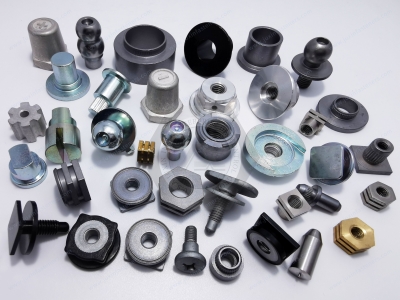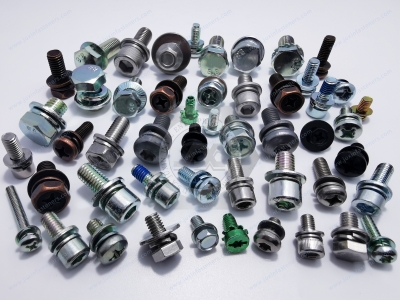Call Us
+86 136 6007 9809
Call Us
+86 136 6007 9809
Oct. 28, 2023
Fastener surface treatment involves forming a covering layer on the workpiece's surface using specific methods. This process aims to give the products a beautiful surface and corrosion-resistant effect.
Fastener surface treatment methods
Surface treatment is the process of forming a covering layer on the surface of the workpiece by specific methods, the purpose of which is to give the products a beautiful surface and a corrosion prevention effect; the surface treatment methods are summarized in the following methods:
1. Electroplating: The parts to be plated are immersed in an aqueous solution containing the deposited metal compounds, and the current is passed through the plating solution so that the plated metal is precipitated and deposited on the parts. General plating has galvanized copper, nickel, chromium, copper-nickel alloy, etc., and sometimes boil black (blueing), phosphating, etc. are also included.
2. Hot-dip galvanizing: This is accomplished by submerging carbon steel parts in a bath of dissolved zinc at approximately 510°C. The result is that the steel part's surface is coated with zinc. The iron-zinc alloy on the steel part's surface gradually transforms into passivated zinc on the product's outer surface. Hot-dip aluminum plating is a similar process.
3. Mechanical plating: The product's surface is impacted by the particles of the plated metal, and the coating is cold welded to the product's surface.
General screws are mostly plated, but hexagonal wood screws used outdoors in electric power, highways, etc., are hot-dipped galvanized; hot-dipped galvanizing is more costly.
Fastener surface treatment plating effect
The quality of plating is measured mainly by its corrosion resistance and secondarily by its appearance. Corrosion resistance is the ability to mimic the product's working environment, set the test conditions, and test it for corrosion. The following aspects control the quality of plated products.
1. fasteners surface treatment appearance: the product surface is not allowed to have local any plating, burning, roughness, gray, peeling, crusting conditions, prominent stripes, not allowed to have pinholes pockmarks, black slag, passivation film loss, cracking, peeling and severe passivation traces.
2. Fastener surface treatment plating thickness: Fasteners in the corrosive atmosphere of the operating life and their plating thickness are proportional. The generally recommended economical electroplated plating thickness is 0.00015in to 0.0005 in (4 to 12um). Hot dip galvanizing: the standard average thickness of 54 um (callout diameter ≤ 3/8 for 43 um), the minimum thickness of 43 um (callout diameter ≤ 3/8 for 37 um)


3. Fastener surface treatment plating distribution: using different deposition methods, plating on the surface of the fasteners gathered in various ways. When plating, the plated metal is not uniformly deposited on the peripheral edges, and thicker plating is obtained at the corners. In the threaded part of the fastener, the thickest plating is located at the top of the threaded teeth, along the threaded side of the thinning, and at the bottom of the teeth at the thinnest deposition. Hot dip galvanizing is the opposite of the thicker plating deposited in the corners and the bottom of the threads; the mechanical plating tends to deposition of plated metal and hot dip plating, but smoother and much more uniform thickness on the entire surface.
4. Fasteners hydrogen embrittlement: In processing and treatment, especially in the plating before the pickling and alkaline cleaning and subsequent plating process, the surface absorbs hydrogen atoms, deposits metal plating, and then captures hydrogen. When the fastener is tightened, the hydrogen is transferred toward the most concentrated part of the stress, causing the tension to increase to a level that exceeds the strength of the base metal and produces a small surface rupture. Hydrogen is particularly active and quickly penetrates the newly formed cracks. This cycle of stress-rupture-infiltration continues until the fastener breaks. This usually occurs within a few hours of the first stress application.
To eliminate the threat of hydrogen embrittlement, fasteners are heated and baked as quickly as possible after plating to allow hydrogen to leach out of the plating. Baking usually occurs at 375-4000F (176-190°C) for 3-24 hours. Since mechanical galvanizing is non-electrolytic, this virtually eliminates the threat of hydrogen embrittlement!
If you are looking for high-quality fastener screws & all kinds of Hose Clamps or technical support for structural design, please get in touch with me.adelajonly@gmail.com. Thanks.
Website: www.juxinfasteners.com
Contact Us
Tel.:
+86 020 8621 0320
+86 020 3121 6067
Technical Support:
Navigation
SEND INQUIREY